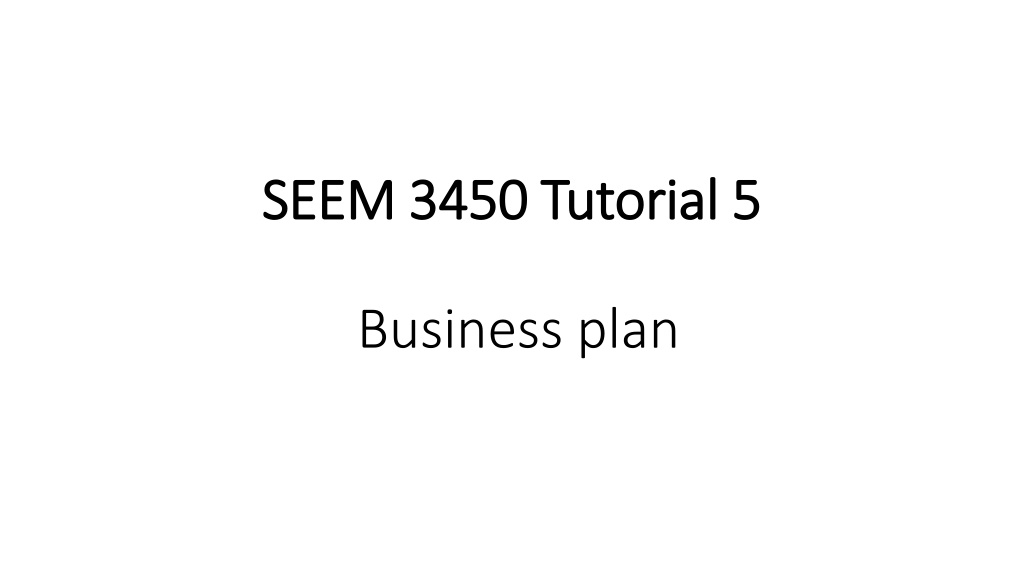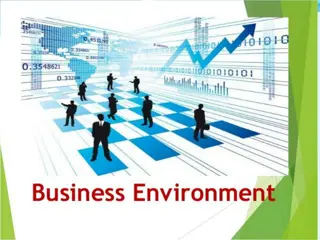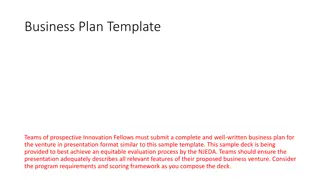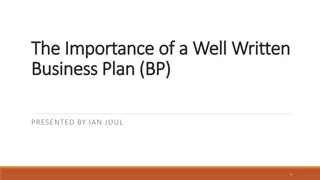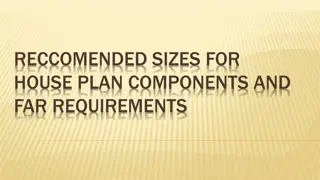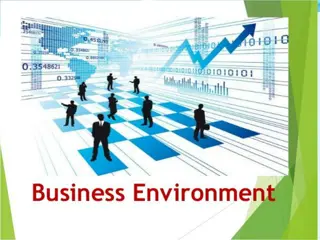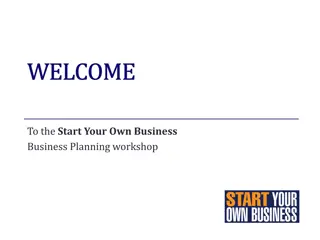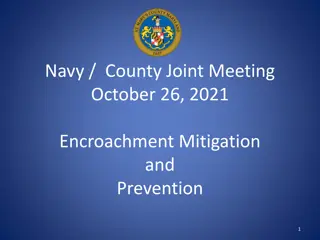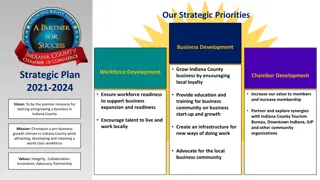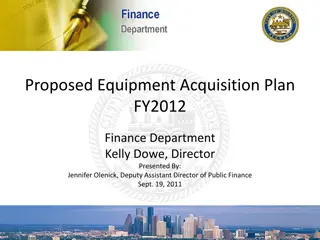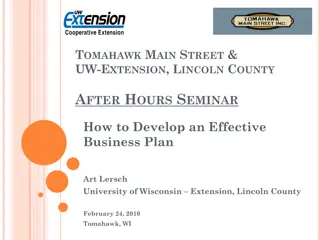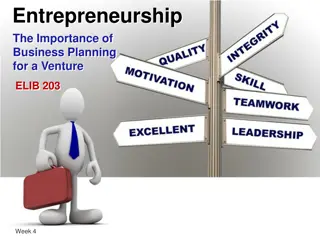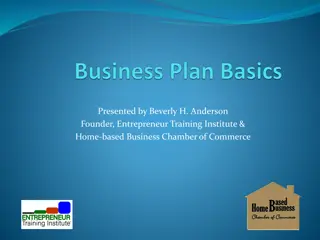Essential Components of a Comprehensive Business Plan
Crafting a successful business plan entails key sections like executive summary, business overview, product/service details, industry analysis, marketing & operations strategies, and financial projections. Each aspect plays a vital role in presenting a clear roadmap for your business idea. Don't overlook the importance of these elements when outlining your entrepreneurial venture.
Download Presentation

Please find below an Image/Link to download the presentation.
The content on the website is provided AS IS for your information and personal use only. It may not be sold, licensed, or shared on other websites without obtaining consent from the author.If you encounter any issues during the download, it is possible that the publisher has removed the file from their server.
You are allowed to download the files provided on this website for personal or commercial use, subject to the condition that they are used lawfully. All files are the property of their respective owners.
The content on the website is provided AS IS for your information and personal use only. It may not be sold, licensed, or shared on other websites without obtaining consent from the author.
E N D
Presentation Transcript
SEEM 3450 Tutorial 5 SEEM 3450 Tutorial 5 Business plan
How to Write Business Plan Executive summary Business overview Products and services Industry overview Marketing strategy Operations plan Financial plan
Executive summary Executive summary should provide: an overview of your business concept, key objectives of your business and your plan, ownership structure, management team, your product or service offering, target market(s), competitive advantages, marketing strategy, and a summary of your financial projections (1 2 pages long). Your executive summary should be written last written last, after you've written the rest of the plan. Each paragraph of the summary should be a summary of the more detailed, related section of the plan.
Business overview Include the following: Legal structure/Ownership: Legal structure/Ownership: Provide the legal business name and organizational structure. B Business s history, vision and/or mission usiness s history, vision and/or mission: Mission statements help define a company s daily business objectives and its approach to achieving them. A Vision statement illustrates future plans or long-term objectives. Progress and Status Progress and Status: Your inspiration and motivation for starting your business. Describe the opportunity that you have found and any progress or achievements you ve made to date. Business Goals and Milestones Business Goals and Milestones: Goals are achievements worth celebrating, so share what defines your success and when you expect to get there (consider using the SMART formula). Milestones share your important To-Do list of activities, representing your path to success (and achieving your goals). Consider your 12-24 month timeline ahead and highlight your start-up, launch, and ongoing planned activities throughout this timeframe.
Products and services Provide a brief introduction to the products or services in your business. This should define the things you have for sale. Highlight what makes you unique or where you have a competitive advantage. Describe the benefits, unique features, defined experience or proprietary aspects that get customers to choose you over other alternatives.
Industry overview Focus your awareness of the true environment and industry segment you are aiming to belong to, and demonstrate the viability of your business by discussing: 1. How large is the industry? Is it growing? What are the key drivers, trends, and influences in the market? 2. Trends; Economic, social and lifestyle trends affecting the industry- what s new? 3. Cultural, environmental or geographical factors that impact the industry- what s happening? 4. Certifications and Industry requirements or government regulations that may be required (if any)? 5. Growth Potential and Future Plans- Is the long-term market outlook sustainable?
Marketing strategy Describe your target market segments, and demonstrate your knowledge in the following areas: 1. Selling Business-to-Consumer or Business-to-Business 2. Demographics Age, gender, occupation(s), income level, education, family status- who is your customer? 3. For B2B type of business, company size, location, number of employees, sales revenues, association or memberships, descriptions of their customers or key stakeholders and influential decision makers. 4. Geographics City, rural or neighborhood profiles, reach or range, access to transportation, online and digital landscape- where will your business and sales actually take place? 5. Psychographics Interests, habits or routine, preferences, values, hobbies -why do they buy? Examples; socially or environmentally conscious, health and wellness preferences, value saving time, communicate via digital media 6. Lifestyle Status, relationships, known associations like athletic and health/wellness preferences or career and family ambitions. 7. Buying Factors / Sensitivity Price, quality, brand name, service, special product features, advertising, packaging, location, store design, ambiance- what triggers their buying behavior? 8. Target Market-- Using a combination of demographic, psychographic, lifestyle, and behaviours, profile your BEST customer. Crafting customer persona(s) are a great way to capture your client s story of doing business with you. You may have more than one target group to consider.
Marketing strategy Describe your competition, how you'll differentiate your products or services, and your products or services unique selling proposition (USP). Discuss product or service pricing and promotion, including how your promotional programs will appeal to each of your target market segments. Provide a plan of traditional and guerrilla marketing tactics, such as tradeshows, press-magnet events, social media marketing (e.g. Facebook, Twitter, etc.), networking, and print, media, or online advertising. Include the cost associated with each tactic. Describe how your products or services will be sold (e.g. storefront, online, wholesalers), and your target markets buying cycle.
Marketing strategy (Details) Describe your competition services unique selling proposition (USP). 1. Who else in this environment sells competing products or services? Anything that may be considered an alternative to what your business provides (please don t say you have no competition). 2. Introduce the group at a high level in one paragraph (the competitive landscape) then give a minimum 3 example companies that you can profile with Strengths they do well and things they can improve upon. May even use a role model company- who would you like to emulate and why? 3. Remember Direct and Indirect competition Direct and Indirect competition. If you are a sandwich shop: Other sandwich shops are direct competition; a sushi restaurant is indirect competition. Both stop a customer from being hungry. Only one of you gets their lunch money. competition, how you'll differentiate your products or services, and your products or Strengths and Weaknesses Weaknesses- things
Marketing strategy (Details) Discuss product or service pricing and promotion, including how your promotional programs will appeal to each of your target market segments. Provide a plan of traditional and guerrilla marketing tactics, such as tradeshows, press-magnet events, social media marketing (e.g. Facebook, Twitter, etc.), networking, and print, media, or online advertising. Include the cost associated with each tactic. Describe how your products or services will be sold (e.g. storefront, online, wholesalers), and your target markets buying cycle.
Operations plan 1. Provide a profile of : 1. 1. Management team Management team (Management team Bios: explain why you are the right person for this job, your staff, partners and advisors), 2. 2. Human resources plan Human resources plan (Personnel, highlighting roles and responsibilities), 3. 3. Business location(s) and facilities Business location(s) and facilities Where will your store, office or operations be located? List any features or requirements for your location (even if you don t have one yet). Repairs, leasehold improvements, regulatory issues, compliance issues can be mentioned here, 4. 4. Production plan Production plan (if selling a product, walk through your production process (even if you provide a service to clients). Describe the production flow from when a customer first discovers your business through to delivering and getting paid). 5. 5. Overview of day Overview of day- -to to- -day operations day operations (Operations defines the processes used to deliver your products and services to the marketplace. This can include staffing, manufacturing, transportation, logistics, travel, policy and procedures, after-sales service and more).
Financial plan This section will explain how much you need; how you arrived at that number; what purchases will be made and how you project to earn back borrowed monies with sales revenue. Show three years worth of projected financial statements, including income statements, pro-forma balance sheets, and monthly cash flow and annual cash flow statements. Summarize each statement into a few easy-to-understand sentences and put these in a cover page for the statements. Be sure to document all of the assumptions you used in forecasting your revenues and expenses.
Reference http://www.smallbusinessbc.ca/starting-a-business/how-write-a- business-plan
